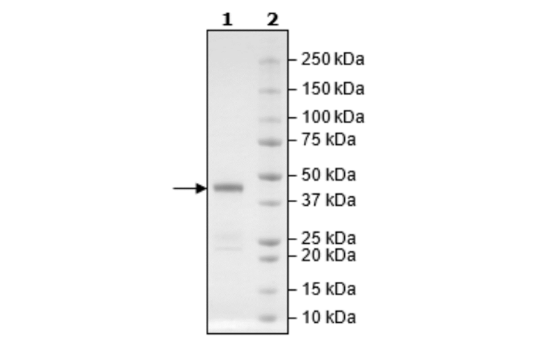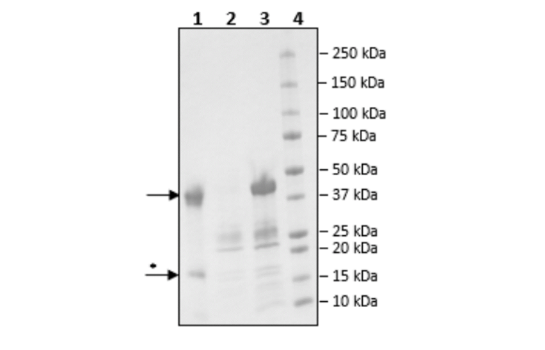CBL-B, His-Avi-Tag, Biotin-labeled (Human) Recombinant
Only %1 left
Catalog #
80412
As low as
$315
*
●
●
Purchase
Description
Recombinant human CBL-B (Cbl proto-oncogene B) encompassing amino acids 39-426 (contains the SH2-like domain). This construct contains a His-tag (6xHis) followed by an Avi-Tag™, linked to the N-terminal end of the protein. The recombinant protein was enzymatically biotinylated using the Avi-Tag™ and affinity purified.
●
Synonyms
E3 ubiquitin-protein ligase CBL-B, RING finger protein 56, SH3- binding protein CBL-B, CBL, CBLB, Casitas B-lineage lymphoma proto-oncogene b, RNF56, RING-type E3 ubiquitin transferase CBL-B, Nbla00127
●
Product Data Gallery
Product Info
Storage and Usage
Citations
Species
Human
Construct
CBL-B (His-Avi-39-426)-(Biotin)
Host Species/Expression System
E. coli
Purity
≥90%
Format
Aqueous buffer solution
Formulation
45 mM Tris-HCl pH 8.0, 124 mM NaCl, 2.4 mM KCl, 10% glycerol, 3 mM DTT
MW
48 kDa
Amino Acids
39-426
Genbank #
NM_170662
UniProt #
Q13191
Label
This protein is enzymatically biotinylated using Avi-Tag™ technology. Biotinylation is confirmed to be ≥90%.
For more information on enzymatic biotinylation, please see our Tech Note.
Background
CBL-B, a RING finger E3-ubiquitin ligase, acts as an intracellular checkpoint and a regulator of cytotoxic lymphocytes and NK cells. CBL-B binds E2-ubiqutin as well as target proteins such as TAM receptor TYRO3, forcing further degradation of TYRO3. CBL-B modulates innate immune responses and plays a key role in host defense to pathogens and anti-tumor immunity. Targeting CBL-B represents a potential therapeutic strategy for the management of human immune-related disorders such as autoimmune diseases, infections, tumors, and allergic airway inflammation. CBL-B has emerged as a new target of interest in the field of immunotherapy due to its ability to suppress cancer immune-evasion. CBL-B initiates anti-cancer immune responses in NK cells in both cytotoxic and effector T cells, promoting T-cell and NK cell activation.
References
1. Jeon, M.S., et al., Immunity. 2004; 21(2):
167-177.
2. Chiang, Y.J. et al., Nature. 2000; 403: 216-220.
2. Chiang, Y.J. et al., Nature. 2000; 403: 216-220.



